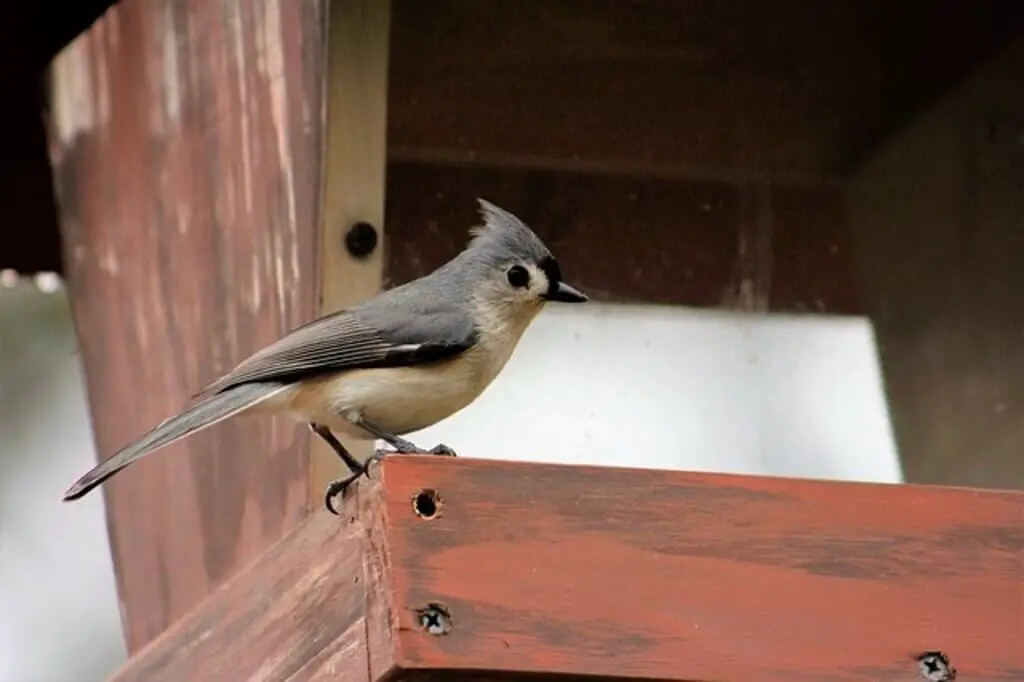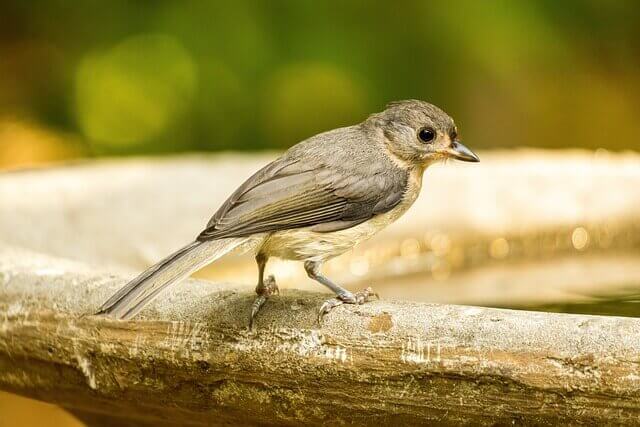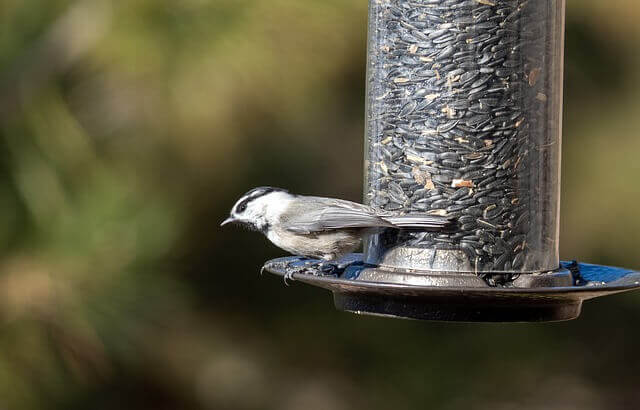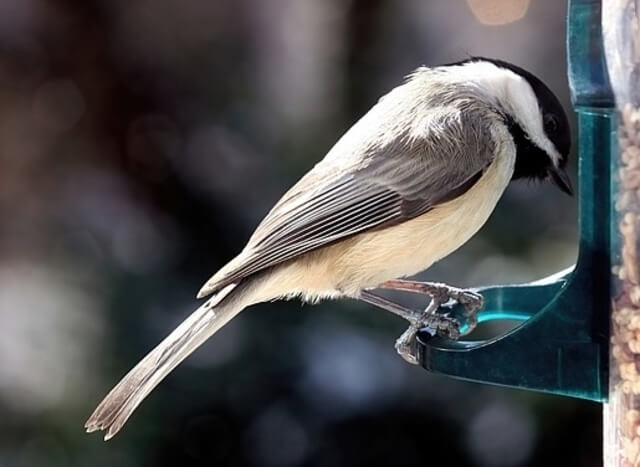Bird-watching, a beloved global hobby, offers both solitude and sociability. Whether you seek avian adventures alone or with friends, the world of birds is a captivating one. From sparrows to eagles and hummingbirds, there’s a diverse array to admire.
Among them, small gray birds with white bellies stand out for their simplicity. Lacking vibrant plumage, these birds gracefully blend into their surroundings. In this article, we’ve curated a list of 14 common species fitting this description, making it easier for you to identify these subtle yet charming backyard visitors.
Table of Contents
Small Gray Birds with White Bellies
Dark-eyed Junco
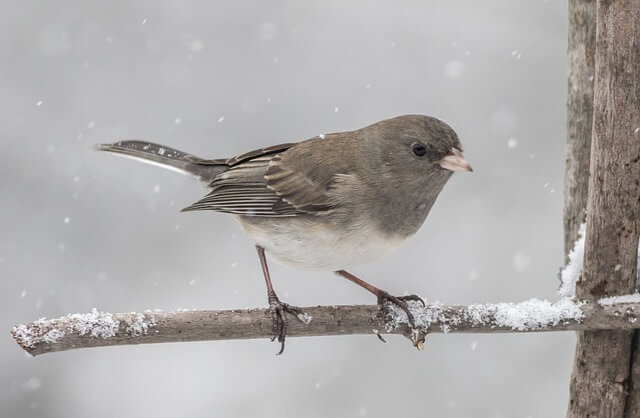
The dark-eyed junco is a small, grayish-brown bird found across North America. They are often mistaken for sparrows, but can be distinguished by their white bellies and the pink bill. The juncos have been known to come in shades of gray or brown with a yellow spot on their forehead that may vary depending on the age of the bird.
Dark-eyed juncos are 12 to 18 cm (5.0 to 7.0 in) long and have a weight of 20 to 30 g (0.65 to 1.06 oz). These birds can be found across much of North America. The dark-eyed junco likes to eat seeds from the ground or plants in trees such as coniferous forests with pine, Douglas-fir, spruce, and fir but also deciduous forests like hickory, oak, cottonwood, aspen, maple.
The winter months are the best time to spot these birds in Canada and the United States. Many people enjoy watching birds during their migrations or nesting seasons.
Tufted Titmouse
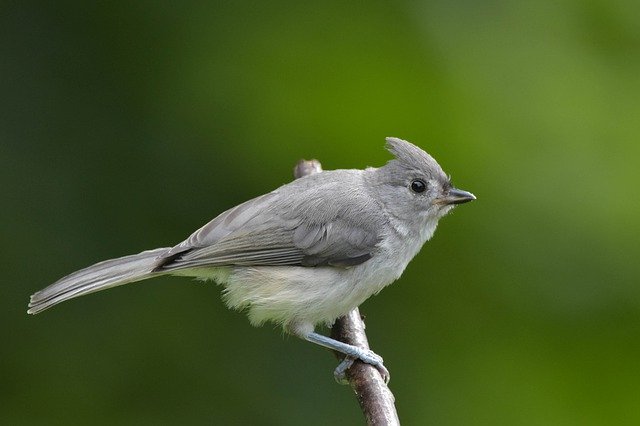
Tufted Titmice are small songbirds from North America. They have a length of 5.5-6.3 in (14-16 cm) and weight of 0.6-0.9 oz (18-26 g). The Tufted Titmouse is found in deciduous and mixed woods as well as gardens, parks, and shrublands across the United States to southern Canada and south through Mexico into Central America to northern South America;.
Tufted Titmice can be identified by their white breast and belly and gray upper body, outlined with orange-brown colored flanks. The black mark just above the beak, which they share with many other birds of this genus, is actually called a “crest” on their head.
They prefer oak, beech, elm and pine trees for nesting. The Tufted Titmouse is an extremely vocal bird that uses sounds to communicate messages about food sources and other things going on in the forest.
Carolina Chickadee
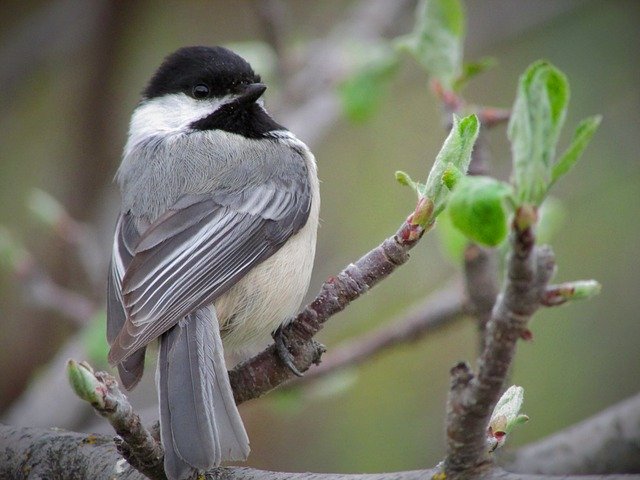
The Carolina Chickadee is a small passerine bird in the tit family, it has a white chest and belly, white with orange brown on the flanks; gray back., has a short black bill, short wings and long tail. This species inhabits deciduous forests in the USA and Canada, preferring areas that are moister or have thicker understory than dry oak-hickory woods or pine barrens.
It migrates south for winter to southern states like Florida, Georgia, and Alabama as well as Mexico. In spring, it returns northward through Mississippi, Arkansas, Missouri, Tennessee and Kentucky before settling back.
It has a diet consisting mainly of insects, seeds and berries; it will also eat other things like mice, eggs, worms and spiders to help it survive winter time. The Carolina Chickadee is one of America’s most common backyard birds!
Eastern Phoebe
Eastern Phoebes are a small passerine bird with a big job. This bird has a small crest on their head, and are usually either gray-brown above, is whitish gray on the throat, chest and underside. The Eastern Phoebe is a migratory bird that nests in North America from April to September then flies south for the winter.
They eat insects and berries but mainly feed on the larvae of flies, beetles, spiders, caterpillars and other bugs. They typically nest in abandoned woodpecker holes near water sources like ponds or streams.
Their nests are made from twigs and leaves lined with moss, hair or feathers to keep them warm. The female lays two eggs which hatch after 14 days into white-feathered chicks that will leave the nest.
Blue Gray Gnat Catcher
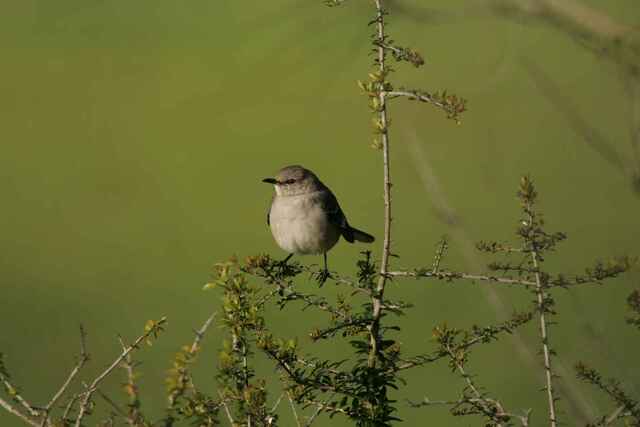
The Blue Gray Gnat Catcher is an insect eating predator. The average length of this animal is 4-5″ inches, and it has bluish gray upper parts with white underparts. It prefers open deciduous woods and shrublands in southern Ontario, the eastern and southwestern United States, and Mexico.
They forage in trees eating insects, insect eggs and spiders. It has long antennae that are used to detect prey by sensing movement, and its compound eyes have at least 30,000 lenses each which help the gnat catcher see in low light conditions.
Its eyes are very large, and they have excellent vision to spot prey from far away distances. The Blue Gray Gnat Catcher prefers to hunt for its food on the ground or in low vegetation by flying close to the ground with quick flights, typically around 2 meters above the ground.
Mountain Chickadee
The mountain chickadee is a common bird in the northern regions of North America. They can be found in the Rocky Mountains, Canada, and parts of Alaska. The bird’s name derives from its call, which sounds like “chick-a-dee”.
The mountain chickadee has a length of 5–6 inches (13-15 cm) and a wingspan of 7.5 inches (19 cm). This particular species prefers to live at high altitudes near streams or small rivers. The mountain chickadee is mainly gray with a black cap that surrounds both eyes and white eyebrows, and a black bib.
Underparts of the bird are whitish gray. The flight and tail feathers are darker gray. These birds prefer insects during the summer, but will switch to conifer seeds and other plant seeds for food as they continue into the fall months.
European Crested Tit
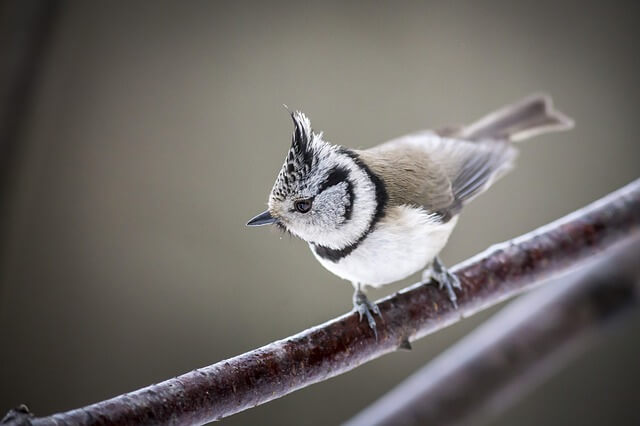
The European Crested Tit is a bird in the tit family. They are usually seen singly or in pairs, often foraging on the ground and searching among leaves and bark of trees for food items such as insects, spiders, seeds and berries. They are agile birds with an acrobatic ability to move along tree branches; they will often hang upside down while feeding. The female builds a neat nest of mosses and lichens that can be found hanging from small twigs.
This species of bird that has been observed in deciduous woodland and coniferous forests throughout central and Northern Europe. It measures 10.5-12 cm long, with a weight of 10-14 g. This particular type of tit has dark gray upperparts and white belly.
It has a black-and-white crest that is typically raised during territorial disputes or when it senses danger. It nests on the ground or in low shrubs close to trees or bushes; its nest is made from moss, leaves, lichen and other vegetation found on the forest floor.
Sagebrush Sparrow
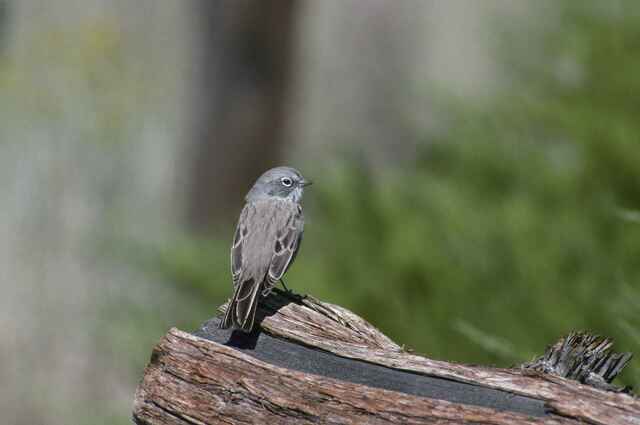
Sagebrush Sparrows are the cutest bird in North America. It is about 4.7-5.9 inches long and weighs 0.5-0.8 ounces, making it one of the smallest birds in North America (excluding hummingbirds). Sagebrush Sparrows are very light brown on top with a gray head, and white underparts. It also has a dark crest in the middle of the breast.
The Sagebrush Sparrow is found throughout North America and breeds from Alaska to Arizona. This bird lives on dry land in areas such as grasslands, prairies, sagebrush fields or shrublands or deserts from Oregon to Mexico and from Utah to Colorado, New Mexico, Arizona, Nevada and California where they can be found nesting on the ground or on low bushes.
Their diet consists of insects, spiders, beetles, grasshoppers, seeds, some fruits, and plant parts.
Black-capped Chickadee
The black-capped chickadee is a small North American bird that is , nonmigratory, and lives in coniferous forests. It has a gray body with white underparts, with rusty brown on the flanks. The black cap overlaps the eyes like a mask and also has a black bib; this feature distinguishes it from other birds of similar size. The Black-capped Chickadee’s size ranges from length of 12–16 cm (4.7–6.0 in), and a weight of 9–15 g (0.32–0.50 oz).
A sighting of this bird should not be taken lightly, as they are quite rare to see during winter months. Black-capped Chickadees are social birds who live in flocks year round but gather together into larger winter roosts. They eat insects such as caterpillars during the summer months and seeds and berries throughout the winter. In some regions of their range they can be quite common, but elsewhere they may only be seen near forest edges or clearings where food is more plentiful.
Black-capped Chickadees live year round in most of Canada south to Virginia; east to Michigan and north central Minnesota; west through Washington Although most people will never see one in their lifetime, they are not rare – they live in backyards all over the country!
Willow Flycatcher
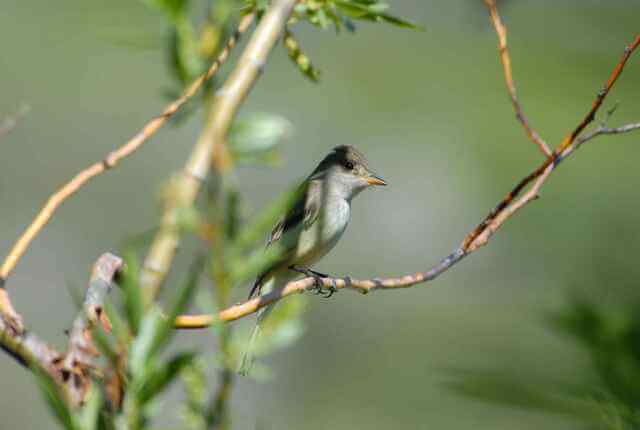
The Willow Flycatcher is one of the most beautiful birds in North America. It has olive-gray upper parts, wings and tail, white underparts, a white eye ring, white wing bars and a small bill. It breeds in deciduous thickets or willows near water all over the United States and Southern regions of Canada.
Tiny Willow Flycatchers are tough to spot in a tree. They are just 130–150 mm (5.2–6 in) in length, and a weight of 13.5 g (0.48 oz). Their diet consists of insects, and common hover flies like aphids and mosquitoes, crane flies or horseflies, can be found at the top of their diet list!
Although these creatures may not seem like much when seen next to other birds, they are fierce competitors for resources because they will chase off larger birds from their territory.
Northern Mockingbird

The Northern Mockingbird (Mimus polyglottos) is a medium-sized bird known for its gray plumage and distinctive white chest and belly. Found throughout North America, these adaptable birds thrive in various habitats, including suburbs and woodlands. Their remarkable ability to mimic a wide range of sounds and their diverse vocalizations make Northern Mockingbirds a beloved species among bird enthusiasts.
Northern Mockingbirds are known for their incredible vocal talents. They can mimic the songs of other birds and even imitate mechanical sounds, such as car alarms. These birds are highly territorial, vigorously defending their nests from potential threats, including predators and humans.
They primarily feed on insects, berries, and fruits, making them valuable for pest control and aiding in seed dispersal. With their striking appearance and musical abilities, Northern Mockingbirds are a delight to observe in your backyard or local parks.
Common Redpoll
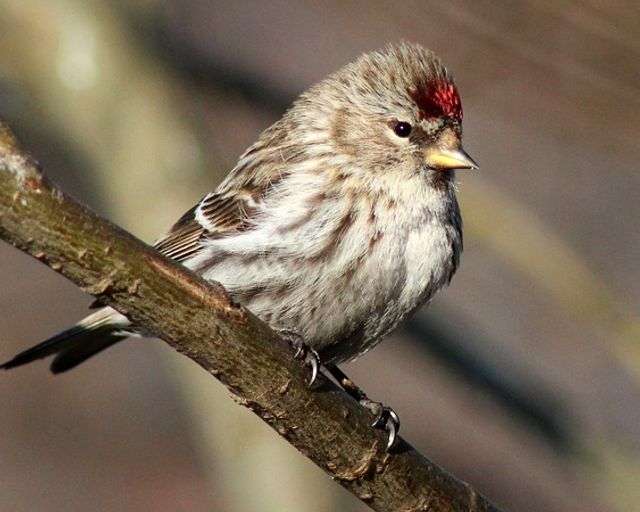
The Common Redpoll, a charming small gray bird, sports a distinctive appearance with its gray plumage adorned with subtle brown streaks that perfectly blend with winter landscapes. One of its defining features is the vibrant red forehead patch and a contrasting black chin. Measuring around 5–6 inches in length, these birds have a dainty yet robust presence.
During the winter months, their diet primarily consists of birch and alder seeds, showcasing their incredible adaptability to cold climates. Their delightful chirps and cheerful presence make them a favorite among bird enthusiasts, brightening up the winter birdwatching experience.
These tiny creatures, with their brown streaks and all, are a true testament to nature’s resilience and beauty.
Vesper Sparrow
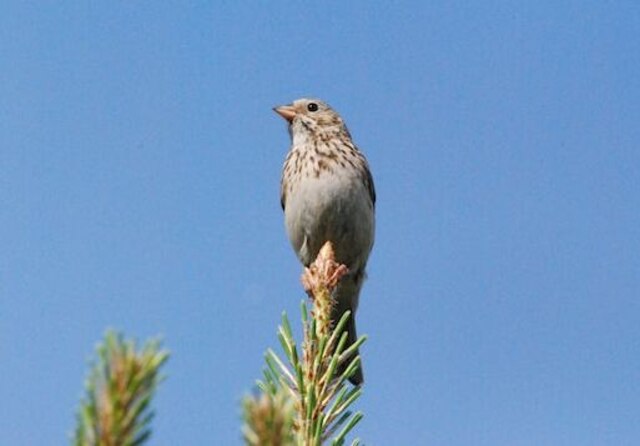
The Vesper Sparrow, a small gray bird with subtle brown streaks, boasts an elegant appearance. It exhibits a delicate mix of gray and beige feathers, while its chest and sides feature charming streaks that add a touch of character. This bird measures approximately 6-7 inches in length, making it a captivating sight in open grasslands and fields.
Known for its melodious evening songs, the Vesper Sparrow serenades the twilight hours with its soothing chirps. Its diet predominantly comprises insects and seeds, reflecting its adaptability to diverse habitats.
Whether perched on a fencepost or foraging in the grass, this sparrow’s understated beauty and enchanting melodies make it a delightful addition to the avian world.
Brown Shrike
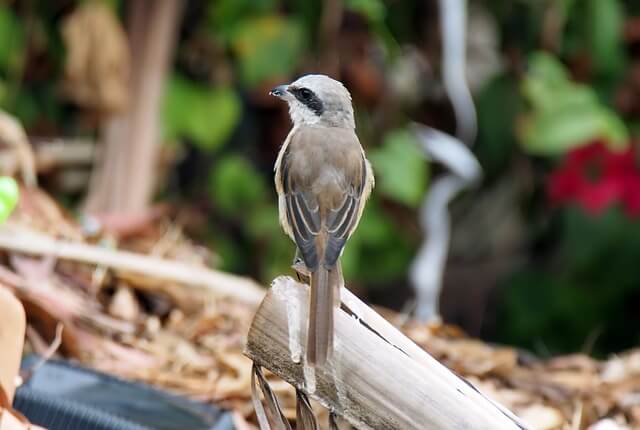
The Brown Shrike, a small gray bird with a distinctive appearance, exhibits elegant gray plumage complemented by fine brown streaks across its body. With an approximate length of 7 inches, these shrikes strike a balance between grace and compactness.
During the breeding season, their grayish-brown upperparts provide camouflage amidst foliage, making them efficient hunters of insects and small vertebrates. They are known for their sharp beaks and carnivorous diet, preying on insects, lizards, and small birds.
A fascinating sight for bird enthusiasts, Brown Shrikes bring their unique blend of grace and ferocity to the avian world, leaving a lasting impression on those who spot them.
How Do I Attract Birds To My Garden?
Attracting birds to your garden can be a rewarding and enjoyable experience. To create a bird-friendly haven in your outdoor space, consider the following steps:
- Provide Food: Offering a variety of bird feeders filled with seeds, suet, and nectar can entice different bird species. Each species may have specific dietary preferences, so offering diverse food sources caters to a wider range of birds.
- Plant Native Trees and Shrubs: Native plants not only provide natural shelter and nesting sites but also attract insects that many birds feed on. Choose a variety of native flora to create a bird-friendly ecosystem.
- Offer Fresh Water: Birds need a reliable source of clean water for drinking and bathing. Installing a birdbath or a small pond can be a magnet for feathered visitors.
- Provide Shelter: Birdhouses, nesting boxes, and dense shrubbery offer suitable shelter and nesting opportunities. Different bird species have specific nesting preferences, so offering a variety of options is beneficial.
- Minimize Chemical Use: Avoid using pesticides and herbicides in your garden, as these chemicals can harm birds and their food sources.
- Maintain Feeders and Clean Regularly: Keep bird feeders clean and well-maintained to prevent the spread of disease. Regularly remove old food and sanitize feeders to ensure the health of visiting birds.
- Use Bird-Friendly Landscaping: Arrange your garden to provide hiding spots and perches for birds. Rocks, logs, and dead trees (snags) can serve as natural features that attract birds.
- Be Patient: Attracting birds may take time, so be patient and persistent in your efforts. Once birds discover your bird-friendly garden, they are likely to return regularly.
- Observe Local Regulations: Ensure that your bird-friendly garden complies with local wildlife protection laws and regulations, especially if you plan to provide nesting sites.
- Educate Yourself: Learn about the specific bird species in your area to tailor your garden to their needs. Field guides and online resources can be valuable references.
By implementing these strategies, you can create an inviting environment that encourages a variety of bird species to visit and thrive in your garden.
Frequently Asked Questions
What is a small bird with a white breast?
The White-Breasted Nuthatch (Sitta carolinensis) is a delightful small bird found across North America. It is recognized by its striking white breast and underparts. Sporting a blue-gray back and a distinctive black cap on its head, this charming bird is a common visitor to bird feeders. White-Breasted Nuthatches are known for their agile and acrobatic behavior as they move headfirst down tree trunks and branches in search of insects and seeds. Their unique nasal calls are often heard in woodlands and suburban areas.
What is a small gray and white bird with a long beak?
The Black-Capped Chickadee (Poecile atricapillus) perfectly matches this description. With its predominantly gray and white plumage, this bird’s distinguishing feature is its relatively long and slender black beak. Found in North America, the Black-Capped Chickadee is a cheerful and sociable bird known for its “chick-a-dee-dee-dee” call. These avian acrobats are frequent visitors to bird feeders, delighting birdwatchers with their lively antics and fondness for sunflower seeds.
What is a gray bird with a black head and white belly?
The Black-Crowned Night Heron (Nycticorax nycticorax) is a bird known for its striking appearance. Although predominantly gray, its black crown and back contrast beautifully with its white belly. This wading bird is often seen near wetlands and water bodies, where it hunts for aquatic prey like fish and amphibians during the twilight hours. Its distinctive call and nocturnal habits make it a unique and captivating species for bird enthusiasts.
What bird looks like a robin but has a white belly?
While the American Robin (Turdus migratorius) shares a similar size and shape with some robins, it is characterized by its orange breast, not a white belly. These robins are a common sight in North American gardens and yards, known for their cheerful songs and earthworm-hunting behavior. They often symbolize the arrival of spring in many regions.
What bird looks like a robin but has a white breast?
The Varied Thrush (Ixoreus naevius) bears a resemblance to a robin but stands out with its distinctive white breast. This bird is native to the western regions of North America. Its striking orange markings on its breast and underparts make it a captivating visitor to gardens and forests. With its melodious song, the Varied Thrush adds a delightful note to the natural symphony of the outdoors.

